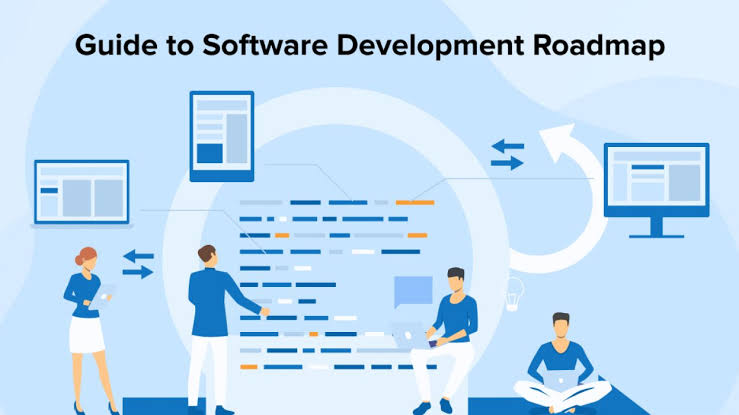
Comprehensive Guide to Crafting a Software Development Roadmap
In today's fast-paced technological landscape, a well-defined software development
roadmap is crucial for delivering successful software projects. A roadmap serves as a
strategic guide, outlining the path from concept to completion, ensuring that every step
aligns with the overarching goals. This article delves into the intricacies of creating an
effective software development roadmap, providing detailed insights into its components, creation process, and best practices.
Introduction to Software Development Roadmap
Asoftware development roadmap is a high-level visual summary that maps out the vision
and direction of a software project over time. It includes milestones, goals, and
deliverables, helping teams stay focused and aligned. By providing a clear plan, a roadmap aids in resource management, risk mitigation, and progress tracking.
Key Components of a Software Development Roadmap
1. Vision and Goals
At the core of any roadmap is a ClearVision and well-defined goals. The vision articulates
the long-term aspirations of the project, while the goals break down these aspirations into
achievable milestones. A clear vision ensures that every stakeholder understands the
project's direction.
2. Timeline A realistic timeline is essential for tracking progress and ensuring timely delivery. It
includes start and end dates for each phase, helping teams stay on schedule and allocate resources efficiently.
3. Milestones
Milestones are significant checkpoints within the project timeline. They represent critical
achievements or deliverables that indicate progress. Setting milestones helps in
measuring success and maintaining momentum.
4. Features and Deliverables
Outlining key features and deliverables ensures that all essential aspects of the software
are addressed. This section details what the software will do and the functionalities it will
include, guiding development priorities.
5. Resource Allocation
Effective resource allocation is crucial for project success. This involves planning the
distribution of resources such as time, budget, and personnel, ensuring that each aspect of the project is adequately supported.
6. Risk Assessment
Identifying and mitigating potential risks early in the process can prevent setbacks. This
involves anticipating challenges and developing strategies to address them, ensuring the
project stays on track.
Types of Software Development Roadmaps
Technology Roadmap
A technology roadmap focuses on the technological advancements and innovations
necessary for the project. It outlines the technical infrastructure, tools, and platforms
required to achieve the project goals
Product Roadmap
A product roadmap details the features, improvements, and market delivery of the
software. It is customer-focused, highlighting how the software will evolve to meet user
needs and market demands.
Project Roadmap
A project roadmap outlines the specific steps and resources required to complete a
particular project. It is task-oriented, focusing on the execution of defined activities to
achieve the project's objectives.
Steps to Create a Software Development Roadmap
1. Define the Vision
Start by defining a ClearVision for the project. This involves understanding the purpose of
the software, the problem it aims to solve, and its long-term goals.
2. Gather Stakeholder Input
Engage with all stakeholders to gather input and align their expectations. This ensures that the roadmap addresses the needs and priorities of everyone involved.
3. Prioritize Features
Rank features based on their importance and feasibility. This helps in focusing on critical
functionalities first, ensuring that the most valuable aspects of the software are developed early.
4. Set Milestones
Establish significant milestones to track progress. These should be realistic and
achievable, providing clear indicators of success at different stages of the project.
5. Allocate Resources
Plan the allocation of resources meticulously. This includes budgeting, scheduling, and
assigning tasks to team members, ensuring that each phase of the project is adequately
supported.
6. Risk Management
Identify potential risks and develop strategies to mitigate them. This proactive approach
helps in minimizing disruptions and keeping the project on track.
7. Review and Adjust
Continuously review and adjust the roadmap as the project progresses. This ensures that the plan remains relevant and responsive to any changes or new insights.
Common Challenges and Solutions
Changing Requirements
Software projects often face changing requirements due to evolving market needs or
stakeholder feedback. Maintaining flexibility within the roadmap can accommodate these changes without derailing the project.
Resource Constraints
Limited resources can hinder progress. Prioritizing tasks and optimizing resource
allocation can help manage constraints effectively, ensuring that critical aspects of the
project receive the necessary support.
Stakeholder Misalignment Misalignment among stakeholders can lead to conflicts and delays. Regular
communication and updates are essential for keeping everyone on the same page and
aligned with the project goals.
Best Practices for Software Development Roadmap
1. Clear Communication
Maintain clear and opencommunication with all stakeholders. This ensures that everyone
is aware of the project’s progress, challenges, and changes.
2. Regular Updates
Regularly update the roadmap to reflect any changes or new developments. This keeps the plan current and ensures that it continues to serve as a reliable guide for the project.
3. Flexibility
Build flexibility into the roadmap to accommodate unforeseen changes. This allows the
project to adapt to new information or changing circumstances without losing momentum.
4. Focus on User Needs
Always keep the end-users in mind. The roadmap should prioritize features and
functionalities that address user needs and deliver value.
5. Collaborative Approach
Adopt a collaborative approach by involving all team members in the roadmap creation
process. This fosters a sense of ownership and ensures that the plan is comprehensive
and realistic.
Conclusion
A well-crafted software development roadmap is a vital tool for guiding a project from
concept to completion. It provides a clear path, helps manage resources, and ensures that all stakeholders are aligned with the project goals. By following the steps and best
practices outlined in this guide, you can create an effective roadmap that leads your
project to success.